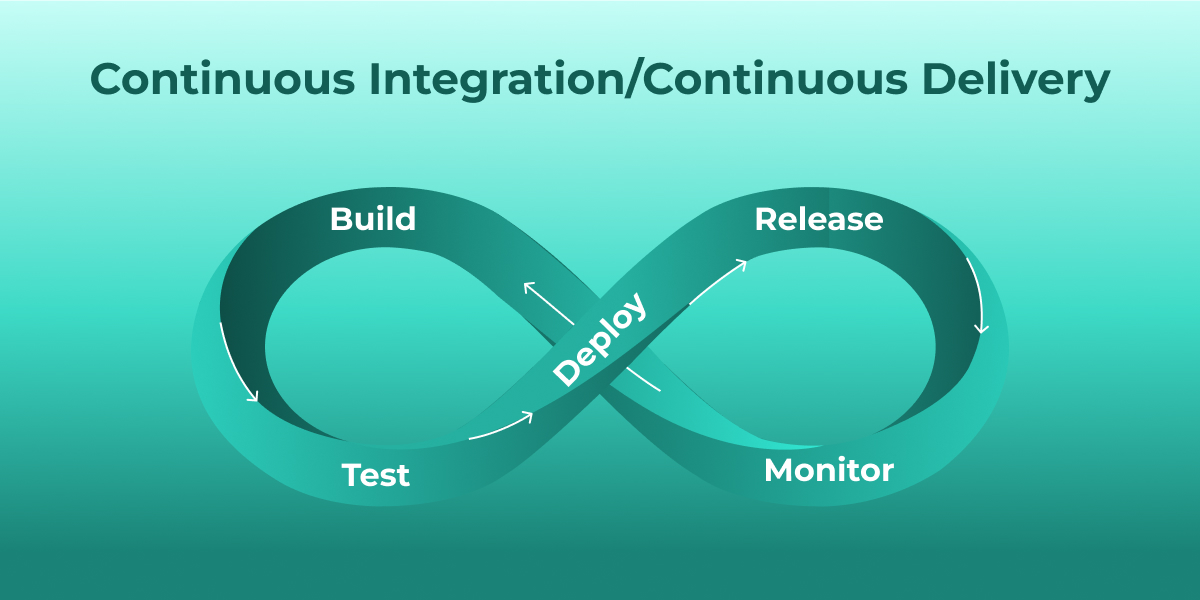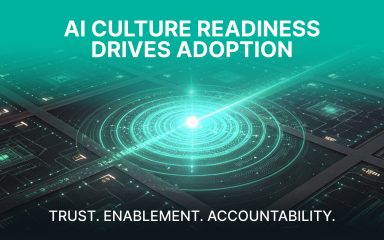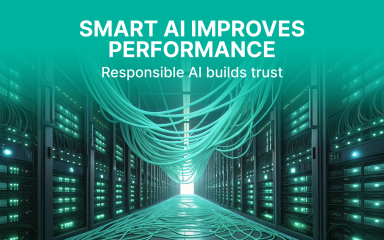Development and operations have traditionally been the two sides of the software development coin, each holding its own responsibilities. Following this approach, development and operations would function as two separate entities that have little connection to one another.
More so, in those few places where the two connect into a delivery pipeline, misunderstanding and conflicts would occur bringing disarray to the product-based development process and hindering the business performance. That is where DevOps comes into the picture, breaking the silos between development and operations and maximizing business efficiency.
According to Forbes, only 4% of organizations consider themselves capable of properly implementing a CI/CD delivery pipeline. The best course of action is to learn more about CI/CD to expertly implement it in your business. DevOps integrates and automates the work of software development (Dev) and IT operations (Ops), it’s a term used to describe a set of practices that enable organizations to improve collaboration between software development and dedicated development teams. DevOps encourages an agile approach to software development, with a focus on short-term and long-term planning and continuous improvement.
Continuous Integration and Continuous Delivery (CI/CD) is an essential part of DevOps and a key component of any modern software development practice. Hence, it seems like shedding a bit of light on how to build and sustain an efficient software delivery pipeline is even more than relevant.
What is CI/CD Delivery Pipeline and What is the Role of DevOps Experts in it?
CI/CD is a process that automates the building, testing, and deployment of applications. It is used to improve an organization’s productivity, increase efficiency, and streamline workflows. The CI/CD delivery pipeline consists of multiple stages – such as “code commit”, “build”, “test”, “deploy”, and “release”. Stages include different jobs like “Build specific part of the code” or “Test that specifit part of the code”.

During each stage, developers can review code, run automated tests, and deploy new features. This process helps ensure that any changes to the codebase are quickly tested and deployed to production. DevOps experts play a critical role in the establishment of effective delivery pipeline, as the professionals who take care of both development and operations processes. They understand the processes and tools necessary to plan, develop, test, and deploy applications in a fast, reliable, and efficient manner. And now that we have established who the DevOps experts are and what they do in broad strokes, let us dive deeper into CI/CD and see what it entails for your organization.
CI/CD Delivery Pipeline Explained: What does it Mean and What Value does it Bring?
Continuous Integration (CI)
Continuous Integration (CI) is a software development process where developers regularly integrate their code with the code base, usually multiple times a day. This process allows teams to identify and fix issues early on, and to keep their code in a stable, workable state. The CI process typically includes the following steps:
- Static Code Analysis
During this step, automated tools inspect the code to identify potential issues and errors. This could include checking for coding standards, linting (checking code syntax), and running basic tests. - Automated Testing
Automated tests are then run to ensure that the code meets the requirements of the software. This can include unit tests, integration tests, and other types of tests. - Tracking of Errors and Security Issues
Errors and security issues are tracked and monitored in order to ensure that any issues are addressed and corrected promptly. - Code Deployment
Once the code passes the tests and checks, it is deployed and ready for use. By following this process, teams can ensure that their code is of high quality and that any errors or security issues are identified and fixed quickly.
Continuous Delivery (CD)
Continuous Delivery (CD) is a software development practice of automating the process of releasing applications and services into production. It is a process that always builds on the Continuous Integration (CI) by automating the entire process from the provisioning of the infrastructure to deploying the application to the testing or production environment. CD usually consists of the following stages:
- Automated Testing
Automated testing is a process that runs tests on the application code to identify any potential errors or issues in the code. This helps to ensure the code is of high quality and can be deployed without any issues. - Configuration Management
Configuration management is the process of controlling, managing, and maintaining the software and hardware configuration of the application throughout the development lifecycle. This includes version control, change management, and tracking of configuration changes. - Deployment
The final stage of continuous delivery is the actual deployment of the application. This involves taking the tested and configured application and deploying it to the production environment. This stage requires careful planning and coordination to ensure the application is deployed without any issues.
The goal of CD is to reduce the risk associated with releasing new code, as well as improve the speed and quality of delivery for end users.
Continuous Deployment – Where Is Its Place?
Continuous Deployment is a process for releasing applications and code into production. It also builds on the processes of CI and CD, meaning it enables DevOps teams to set up criteria for code releases ahead of time, and if the criteria are met and validated, the code is automatically deployed into the production environment.
In most cases, CD unfolds as follows:
● Build
In this stage, the code is compiled and all the tests are executed. It is also known as the “Verification” stage.
● Test
After the code is successfully built, the tests are executed on the code. It is also known as the “Validation” stage.
● Deploy
In this stage, the code is deployed to a staging environment. This is where the code is tested in a real-world environment. The staging environment is usually a replica of the production environment.
● Release
After the code is tested and verified in the staging environment, it is released to production. This is the last stage in the CI/CD pipeline.
● Monitor
Once the code is released to production, it needs to be monitored for any errors. This is done by monitoring tools such as New Relic or AppDynamics.
Additionally, Continuous Deployment helps to reduce the risk associated with manual code deployments and helps to ensure every change is tested to the same standards. By automating the code release process, teams can focus on developing new features and improving the customer experience.
Should the Continuous Integration Go Before the Continuous Deployment In A Delivery Pipeline?
You cannot build a house without a solid foundation unless you do not care about its longevity. Continuous Integration should always go before Continuous Deployment, and you can’t have one without the other. CI is an important step for companies to take before deploying their software in production. CI helps to ensure that the software is tested and built properly before being released. It also helps to detect bugs and errors early in the development process, reducing the amount of time and effort needed to fix them. The connection between CI and CD is that they are both parts of a DevOps workflow that ensures that software is built, tested, and deployed as efficiently as possible.
Without CI, it would be difficult to deploy code consistently and reliably. Besides, CI also helps to reduce the amount of manual work required for software deployments. It automates the build and testing process, allowing developers to focus on writing code, rather than manually verifying it. Additionally, CI helps to increase the visibility of code changes, allowing developers to quickly detect and fix errors before they become major issues. Moreover, the very combination of CI\CD practices makes a delivery pipeline finally built and set to deliver value for the business.
The Fundamentals of CI/CD and their Meaning for Your Business
As we already understood, the Continuous Integration/Continuous Delivery (CI/CD) is a set of practices that enable developers to rapidly, reliably, and repeatedly build, test, and deploy software. It is a process that helps developers quickly produce software and make it available to the public. But there is much more to it, so here are the fundamentals of CI/CD delivery pipeline you should know about and the reasons to implement CI/CD in your organization.
- A Single-Source Repository
This is the main repository (or codebase) where all developers store and maintain their code. It is the primary source of code that is used in the CI/CD process. This repository is used by all developers and should be kept up-to-date with the latest source code. This repository should be organized and easily accessible so that developers can quickly access the code they need. - Frequent Check-Ins to the Main Branch
This refers to the practice of regularly committing code to the main branch of the single-source repository. By committing code regularly, developers ensure that the latest changes to the codebase are always reflected in the repository. This practice also helps ensure that the codebase is kept up-to-date with the latest source code. - Automated Builds
Automated builds are used to quickly and easily compile the code from the single-source repository. This process allows developers to quickly and easily validate their changes and create a deployable artifact for testing or deployment. Automated builds can be triggered by changes in the codebase or on a regular schedule. - Self-Testing Builds
Self-testing builds are an essential part of continuous integration/continuous delivery pipelines. A self-testing build is a process in which automated tests are run against the software codebase to check for errors, bugs, and other issues. This is usually done by running unit tests, integration tests, and other tests depending on the software. Self-testing builds help to ensure that the software is of high quality before it is released. - Frequent Iterations
Iterations are a key part of the CI/CD process. Frequent iterations allow for frequent feedback, which can be used to make the software better. Iterations allow for quick fixes and updates to be made, reducing the risk of errors and bugs. - Stable Testing Environments
Stable testing environments are essential for successful CI/CD implementations. This ensures that tests are run in a repeatable and predictable manner. A stable testing environment should be set up with all the necessary tools and frameworks in order to ensure that tests can be run on a consistent basis. - Maximum visibility
Maximum visibility is a key element of CI/CD delivery pipeline and refers to the practice of ensuring that the entire development process is open and accessible to the entire team. This means that everyone involved in the development process can see the progress of the project at any given time, which helps to keep everyone on the same page and reduce the chances of mistakes or miscommunication. Maximum visibility also helps to reduce the risks of unexpected changes or delays, as everyone can quickly spot any issues or potential problems early on. - Predictable deployments anytime
Predictable deployment anytime is also a important key element of CI/CD delivery pipelines. This refers to the practice of ensuring that the process of deploying new code or features is as consistent and predictable as possible. This helps to ensure that the project is always up-to-date and that any new changes or features are deployed in a timely manner. This also helps to reduce the chances of code conflicts or other unexpected issues. Predictable deployments also make it easier to test and debug any new code or features before they are deployed in production.
What is Infrastructure as Code (IaC)?
Infrastructure as Code (IaC) is a process of managing and provisioning infrastructure through code rather than manual processes. It allows infrastructure to be managed in a version control system, providing an automated, repeatable, and reliable way to deploy an environment. IaC also helps organizations improve scalability, agility, and cost management. These are critical concerns for many organizations, especially in light of the 2022 tech crash that left the boards of directors across the tech industry scratching their heads looking for cost optimization opportunities.
Apart from cost optimization, IaC provides businesses with confidence when managing their CI/CD pipelines. The main point to consider when talking about IaC is that it uses code to define, manage, and version infrastructure, allowing organizations to have more control and visibility into their project infrastructure. This allows for faster and more reliable deployments, as well as easier scalability and the ability to roll back changes if needed.
At the end of the day, IaC is an important factor to consider when designing and managing a project’s infrastructure, as it can help to ensure reliability, scalability, and cost savings.
How a Good CI/CD Strategy Generates Business Value
A good CI/CD strategy is incredibly valuable to a business as it helps ensure that changes to a product or service are made quickly, efficiently, and with minimal disruption to operations. It can also reduce the time and effort needed for manual deployments, allowing for faster time to market. A successfully implemented CI/CD strategy allows for greater collaboration between teams, enabling them to work together more effectively and efficiently.
- Shorter time-to-market processes results in faster ROI
Automated processes in delivery pipelines can eliminate manual steps and reduce the risk of errors, resulting in quicker release cycles and fewer resources required for maintenance. Additionally, faster time-to-market can mean more rapid feedback loops, allowing businesses to quickly identify and address customer needs. This feedback can then be used to improve the product or service, leading to increased customer satisfaction and loyalty, as well as increased sales and revenue. Most importantly, the faster you launch, the faster you’ll generate a much-coveted ROI for your business. - Development cost reduction thanks to automation
A properly implemented CI/CD strategy opens opportunities for automation, which helps reduce development costs as it eliminates the need for manual labor. Automating processes allows teams to focus on higher-value activities such as developing features, testing, debugging, and analyzing data. Automation can also ensure that procedures are followed consistently and precisely, reducing the risk of errors and ensuring better quality control. Ultimately, automation helps teams to become more efficient, productive, and cost-effective.Automation also leaves more space for creativity within your development team. Not being bothered by the monotonous and repetitive labor, the team might come up with new ideas to improve your product even further. Such improvements might prove to be vital in the future and generate more value for your business. - Incremental approach to development
A good CI/CD strategy that utilizes an incremental approach in development provides businesses with a number of key benefits. By deploying code more frequently and quickly, businesses can receive revenue faster as the code is live and generating income. Basically, what you get is a constantly improving product that can react to the changes in customer feedback on the go. Whenever a new trend occurs or good ideas come in, the DevOps team can implement the necessary iterations to further improve the product and generate more value out of it.Additionally, by deploying code more quickly, businesses are able to respond more quickly to customer feedback, making sure they are meeting customer needs as they arise. Finally, by deploying code incrementally, businesses are also able to identify and fix bugs or other issues faster, minimizing their impact and reducing the risk of them occurring in the first place. So, whenever a problem occurs, the downtimes would be minimal, saving you time and money on making the necessary fixes. - Increased business continuity
As mentioned earlier, with a properly implemented CI/CD pipeline, you can also reduce or even completely eliminate the downtimes in case of any technical issues. This would help you avoid the mistakes that lead to loosing customers. Everything can be fixed quickly and on the go so that your customers are not affected by any delays and your business does not lose money. With automation comes a greater ability to maintain a consistent and reliable environment, which leads to increased reliability and stability of applications, as well as improved customer service and satisfaction.Automated pipelines also help ensure that changes are quickly deployed, allowing for faster time to market for new products and services. Finally, a good CI/CD strategy allows for better visibility and control of the entire delivery process, helping to ensure that the desired long-term goals are achieved. - More chances to make a difference leads to happier employees
A well-oiled CI/CD pipeline also makes it easier for new team members to join and be productive quickly. The automation of deployment and testing helps reduce the learning curve and makes it easier to develop and deploy applications faster. This helps in retaining talent as well, as people are more likely to stay when they feel like they are making a difference.Another essential point is the decrease of the manual labor burden on the teams. Tedious and repetitive tasks kill the creativity in any individual, and cutting such tasks may allow your employees to unveil their true potential. They will be able to generate more valuable ideas for the business and implement them in a much more creative and effective way. Finally, a solid CI/CD pipeline also allows for easier collaboration between teams. Teams can work together on projects and deploy them quickly and easily, increasing the team’s overall productivity. This creates a positive work environment and makes it easier to attract and retain talent. - Faster identifying and fixing any issues makes higher satisfied customers
A thought-out CI/CD strategy enables teams to continuously integrate and deliver changes to their software while ensuring the quality and value of their product. This is achieved by using automated tests, such as unit tests or end-to-end tests, that are triggered each time new code is added to the codebase. These tests check for bugs and errors before the changes are deployed to production.Having a solid CI/CD strategy in place allows teams to quickly identify and fix any issues with their codebase before they reach the end user. Since users and customers don’t have to deal with any unexpected errors and issues, they have a better experience with the product. This improved customer satisfaction, confidence, and reputation can bring in more users and customers, leading to increased revenue for the business. Additionally, having fewer bugs and errors in production can save teams time and money as they don’t have to spend as much time fixing bugs and errors that have already been released.
What are the Business Impacts of Poor CI/CD?
Poor CI/CD can have a significant impact on the success of a business. Without proper CI/CD, businesses can experience longer development cycles, higher costs, and a drop in customer satisfaction. Failure to establish an effective CI/CD strategy can lead to inefficient deployments, which can result in increased time to market, increased costs, and potential product quality issues. Let us have a closer look at the major challenges associated with poorly executed CI/CD.
- Irrelevant costs
Irrelevant costs resulting from poor CI/CD delivery pipelines can be significant for any business. Without a streamlined CI/CD process, IT departments often spend their budgets on undifferentiated engineering. This means that the IT team is spending time on tasks that do not add any value to the company, such as manually pushing out code updates, configuring machines, and performing other manual tasks. This can result in IT staff spending time they could be using to develop more advanced applications or features instead, wasting precious resources and time. - Delayed and unrealized revenue
Bugs, security vulnerabilities, and other issues that can be prevented or caught earlier in the development process can lead to a poor user experience and a potential loss of customers. Poor CI/CD processes can lead to longer development cycles, which can be costly in terms of time, resources, and money. Additionally, if a bug or security vulnerability is discovered late in the development cycle, it can be costly to fix. - Missed opportunities and decreased productivity
Poor CI/CD processes can lead to delays in launching new features and product updates, potentially missing out on valuable market opportunities. Poor CI/CD processes can lead to developers spending more time fixing bugs and deploying applications, reducing the amount of time they can spend developing new features. - Devs burnout
Inefficient CI/CD delivery pipeline can lead to an increase in developer burnout, as developers are required to frequently put in extra hours to solve issues that arise from a lack of automation. This can lead to lower developer productivity as they are spending less time writing efficient code and more time troubleshooting and debugging. It can also lead to lower developer happiness, as the extra work can be frustrating and demoralizing.
Why is CI/CD Delivery Pipeline Essential for the Success of Your Business?
CI/CD is an important process for modern businesses because it streamlines and automates the software development process, allowing developers to focus on creating innovative solutions. This automation eliminates tedious and time-consuming manual development work, as well as legacy approval processes, allowing DevOps teams to work more quickly and efficiently. Additionally, CI/CD delivery pipelines helps ensure that software is released with greater quality, reliability, and security. By automating testing and deployment, errors are identified and corrected much faster, resulting in fewer costly disruptions. In essence, CI/CD helps organizations reduce costs, speed up their time to market, and remain competitive in their respective industries.
Modern business outpaces those who are not ready or not willing to keep up with their competition. Hiring a reliable technology partner might be one of the best decisions a business makes to dominate the market. As a matter of fact, having someone who can set up and support an efficient delivery pipeline for your product is rather an investment and not an expense. Contact us, we will make sure the ROI on your technology investment is on point.












